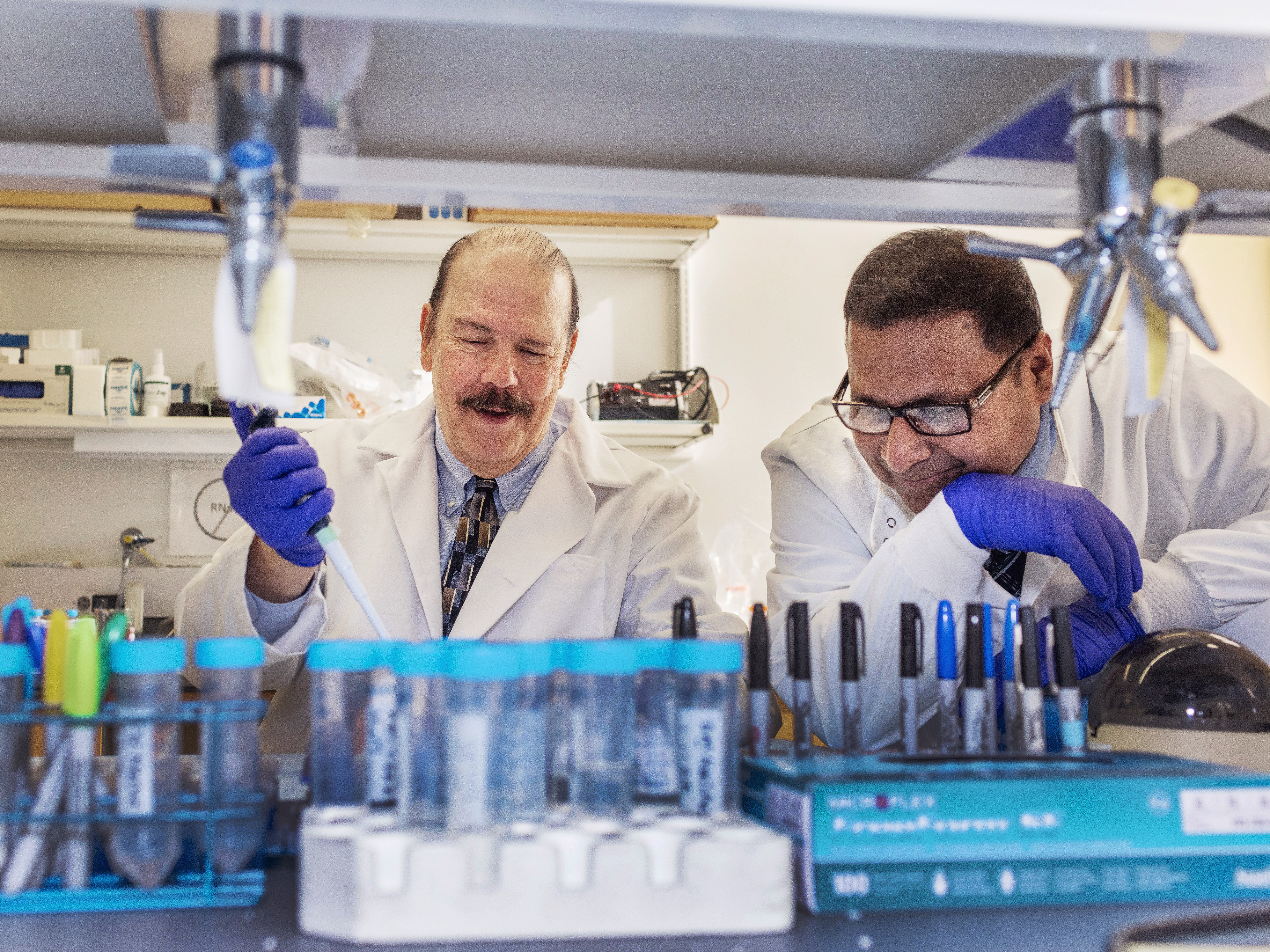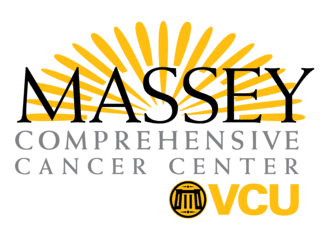Latest News
Research & Innovation
“We’re aiming for a cure.” Massey and VIMM researchers achieve potential breakthrough in brain cancer treatment
Jun 24, 2025
 An innovative study – led by Paul B. Fisher, MPh, Ph.D., FNAI, and Swadesh K. Das, Ph.D. – created a Fusion Superkine (FSK) that demonstrated the capability to introduce a combination of treatment outcomes – to potentially achieve a breakthrough in the treatment of glioblastoma brain cancer. (Photo credits: Daniel Sangjib Min, MCV Foundation)
An innovative study – led by Paul B. Fisher, MPh, Ph.D., FNAI, and Swadesh K. Das, Ph.D. – created a Fusion Superkine (FSK) that demonstrated the capability to introduce a combination of treatment outcomes – to potentially achieve a breakthrough in the treatment of glioblastoma brain cancer. (Photo credits: Daniel Sangjib Min, MCV Foundation)
RICHMOND, Va. – June 24, 2025 – Researchers at VCU Massey Comprehensive Cancer Center and the VCU Institute of Molecular Medicine (VIMM) discovered a new and potentially revolutionary way to treat glioblastoma (GBM), the most aggressive type of brain cancer with no curative treatment options. An innovative study – led by Paul B. Fisher, MPh, Ph.D., FNAI, and Swadesh K. Das, Ph.D., and published Monday in the Journal for ImmunoTherapy of Cancer – created a new molecule that demonstrated the capability to introduce a combination of treatment outcomes – direct toxicity and immunotoxicity – to kill the tumor while exploiting immunotherapy to potentially prevent the recurrence of GBM via a “Fusion Superkine” (FSK), containing dual acting therapeutic cytokines in a single molecule.
“This is the tip of the iceberg,” said one of the study’s senior authors, Paul B. Fisher, MPh, Ph.D., FNAI, the Thelma Newmeyer Corman Endowed Chair in Cancer Research at Massey, director of the VIMM and professor in the Department of Cellular, Molecular and Genetic Medicine. “We’re optimistic that our first trial in brain cancer, planned for 2026, will show that the IL-24 gene and these therapeutic viruses are effective and safe. And [the FSK] will be the one knocking it out of the ballpark.
“We’re aiming for the ’holy grail;’ a cure for this devastating cancer.”
Fisher added, “Our novel systemic therapy for brain cancer incorporates a unique immune-therapeutic agent, a ‘Fusion Superkine’ (FSK), and an innovative viral systemic delivery approach, focused ultrasound double microbubble (FUS-DMB), which permits safe and effective targeted delivery through the blood-brain barrier (BBB) into the brain.”
Glioblastoma is a highly aggressive and invasive (malignant) form of primary brain cancer, currently considered incurable. As a “cold tumor,” GBM presents a tumor microenvironment that suppresses immune activity and response to therapy. Some treatments can slow cancer growth and reduce symptoms, but do not prevent the inevitable progression of the disease. Currently, the recurrence rate of GBM is greater than 90% within six to nine months after initial therapy. When the tumor regrows, it tends to be even more resistant to therapies, including chemotherapy and radiation therapy, inevitably resulting in patient death.
To render GBM amenable to therapy, the investigators explored a dual-targeting strategy by creating the FSK, which is made up of two distinct cytotoxic and immune-modulating molecules. By intravenously administering and selectively targeting the delivery of two immune-activating cytokines – secreted proteins that control the growth and activity of multiple cell types, including immune cells in the body – one that selectively induces tumor cell death in combination with an immune-modulating cytokine, the traits that make GBM so difficult to treat can be attacked.
To achieve those objectives, Fisher and Das created a unique FSK, combining the cytotoxic properties of a next generation version of melanoma differentiation associated gene-7/Interleukin-24, IL-24S (Superkine), with enhanced secretion, stability and bioactivity, and the immune-activating properties of IL-15 to maximize therapeutic outcomes. In their GBM immunocompetent mouse tumor model, the FSK stimulated higher tumor regression and enhanced survival in vivo more than the individual ‘Superkine’ (IL-24S) or cytokine (IL-15) in glioblastoma cancer models. Killing of GBM cells was induced, as well as increased tumor infiltration of T cells, dendritic cells (DCs), macrophages and NK cells, all of which work together to attack and destroy the tumor.
GraphicalAbstract(1).png) The Fusion Superkine (FSK) stimulated higher tumor regression and enhanced survival in vivo more than the individual ‘Superkine’ (IL-24S) or cytokine (IL-15) in glioblastoma cancer models. In addition, killing of GBM cells was induced, as well as increased tumor infiltration of T cells, dendritic cells (DCs), macrophages and NK cells, all of which work together to attack and destroy the tumor.
The Fusion Superkine (FSK) stimulated higher tumor regression and enhanced survival in vivo more than the individual ‘Superkine’ (IL-24S) or cytokine (IL-15) in glioblastoma cancer models. In addition, killing of GBM cells was induced, as well as increased tumor infiltration of T cells, dendritic cells (DCs), macrophages and NK cells, all of which work together to attack and destroy the tumor.
In order to efficiently administer the fusion “Superkine,” researchers created a type 5 adenovirus (Ad.5) expressing the FSK and then innovated a novel targeted delivery by pairing a focused ultrasound (FUS) and microbubbles (MBs), FUS-DMB, strategy to safely transport the FSK and overcome the limitations of systemic viral delivery and selectivity of the BBB.
The tight junctions in the endothelial cells of the blood-brain barrier (BBB) restrict the passage of most molecules, impeding the effectiveness of chemotherapies and cancer treatments by limiting entry into the brain. The FUS-DMB approach avoids these restrictions, allowing ‘stealth’ transport of the Ad.5-FSK in the bloodstream, and reversibly and safely opening the BBB, thereby allowing access to the tumor and effective therapy by the FSK.
“Our ‘Fusion Superkine’ represents a distinctive platform for immune-gene therapy that not only eradicates tumor cells but also boosts localized immune activity, resulting in prolonged effects,” said Swadesh K. Das, Ph.D., a member of the Cancer Biology research program at VCU Massey Comprehensive Cancer Center, associate professor and graduate faculty in the Department of Cellular, Molecular and Genetic Medicine at the VCU School of Medicine and a member of the VIMM.
Peers were similarly struck by the significance of the study, with one reviewer commenting, “The engineering and successful testing of an adenoviral vector capable of simultaneously delivering two distinct cytokines represent a significant milestone in virus-based immunotherapy development. Previous attempts to construct adenoviral vectors co-expressing multiple therapeutic genes have often encountered challenges, including compromised virus assembly and suboptimal gene expression. In this study, the authors have successfully addressed these limitations by engineering Adenovirus expressing a Fusion Superkine (FSK) transgene that combines IL-24S and IL-15 (Ad5FSK).
The peer reviewer goes on to say, “A particular strength of this work is the noninvasive delivery method. The use of focused ultrasound double-microbubble (FUS-DMB) technology for systemic adenovirus delivery into the brain is a groundbreaking advancement, as it can enable the virus to pass the blood-brain barrier and facilitate the targeted delivery of therapeutics to brain tumors and could be extended to other therapeutic viral vectors.
“In summary, this study will undoubtedly contribute valuable insights into the fields of immunotherapy and virotherapy and serve as a foundation for future research in this area. The innovative design of the Ad5FSK, its enhanced therapeutic and immunomodulatory effects, and the use of FUS-DMB for noninvasive delivery represent a very versatile and impactful platform for advancing virus-based immunotherapies for brain cancer.”
The double microbubble delivery approach also shows promise in delivering viruses and other genetic medicines to attack other tumor types. The FUS-DMB permits enhanced entry of molecules into target sites in addition to the brain, resulting in improved delivery of molecular medicines and enhanced therapeutic outcomes.
Future research is planned to expand the use of a FSK in clinical tumor samples, and ultimately, in patients.
As Fisher noted: “The bottom line is that in the future we may be able to treat both primary brain tumors (glioblastoma) and secondary brain tumors (arising from metastases outside of the brain) non-invasively without surgery.”
Complete List of Authors: Kumar, Amit; VCU Institute of Molecular Medicine, Virginia Commonwealth University, School of Medicine; Virginia Commonwealth University School of Medicine, Cellular, Molecular and Genetic Medicine. Bhoopathi, Praveen; VCU Institute of Molecular Medicine, Virginia Commonwealth University, School of Medicine; Virginia Commonwealth University School of Medicine, Surgery, Division of Surgical Oncology. Mannangatti, Padmanabhan; VCU Institute of Molecular Medicine, Virginia Commonwealth University, School of Medicine; Virginia Commonwealth University School of Medicine, Cellular, Molecular and Genetic Medicine. Maji, Santanu; VCU Institute of Molecular Medicine, Virginia Commonwealth University, School of Medicine; Virginia Commonwealth University School of Medicine, Human and Molecular Genetics. Pradhan, Anjan; VCU Institute of Molecular Medicine, Virginia Commonwealth University, School of Medicine; Virginia Commonwealth University School of Medicine, Human and Molecular Genetics. Madan, Esha; VCU Institute of Molecular Medicine, Virginia Commonwealth University, School of Medicine; VCU Massey Comprehensive Cancer Center, Virginia Commonwealth University, School of Medicine; Virginia Commonwealth University School of Medicine, Surgery, Division of Surgical Oncology. Gogna, Rajan; VCU Institute of Molecular Medicine, Virginia Commonwealth University, School of Medicine; Virginia Commonwealth University School of Medicine, Cellular, Molecular and Genetic Medicine; VCU Massey Comprehensive Cancer Center, Virginia Commonwealth University, School of Medicine; Virginia Commonwealth University School of Medicine, Surgery, Division of Surgical Oncology, Limbrick, David D.; Virginia Commonwealth University School of Medicine, Chair of Neurosurgery, VCU Institute of Molecular Medicine, Virginia Commonwealth University, School of Medicine. Klibanov, Alexander L.; University of Virginia, Division of Cardiovascular Medicine, Department of Biomedical Engineering. Emdad, Luni; VCU Institute of Molecular Medicine, Virginia Commonwealth University, School of Medicine; Virginia Commonwealth University School of Medicine, Human and Molecular Genetics; VCU Massey Comprehensive Cancer Center, Virginia Commonwealth University, School of Medicine. Das, Swadesh K.; VCU Institute of Molecular Medicine, Virginia Commonwealth University, School of Medicine; Virginia Commonwealth University School of Medicine, Human and Molecular Genetics; VCU Massey Comprehensive Cancer Center, Virginia Commonwealth University, School of Medicine. Fisher, Paul B.; Director, VCU Institute of Molecular Medicine, Virginia Commonwealth University, School of Medicine; Virginia Commonwealth University School of Medicine, Department of Cellular, Molecular and Genetic Medicine; VCU Massey Comprehensive Cancer Center, Virginia Commonwealth University, School of Medicine
The present study was supported in part by the National Foundation for Cancer Research (NFCR) (PBF), Sherman Fairchild Foundation (PBF), Thelma Newmeyer Corman Endowment (PBF), developmental funds from the VCU Institute of Molecular Medicine (AK, LE, SKD, PBF), research support from the Department of Human and Molecular Genetics (AK, PB, LE, SKD), a sponsored research agreement with InterLeukin Combinatorial Therapies, Inc. (ILCT) (LE), Commonwealth Commercialization Fund (SKD), the Commonwealth Health Research Board (SKD), and National Cancer Institute Cancer Center Support Grant to VCU Massey Comprehensive Cancer Center P30 CA16059 (Dr. Robert Winn, PBF). NIH/NCI R01 CA259599 (PBF and XY Wang) and P01 CA275740 (PBF and D Sarkar). PBF is co-founder, consultant and has equity interest in ILCT. VCU also is an equity owner in ILCT.
Related News
Research & Innovation
Targeted drug could benefit pediatric and young adult patients with invasive soft tissue cancerNov 18, 2025
Research & Innovation, Community Engagement
Massey launches Brushstrokes of Discovery art initiative to celebrate the relationship between cancer patients and researchersNov 14, 2025
Research & Innovation
VCU senior hopes to improve prostate cancer treatment through researchNov 3, 2025

Get access to new, innovative care
Treatments in clinical trials may be more effective or have fewer side effects than the treatments that are currently available. With more than 200 studies for multiple types of cancers and cancer prevention, Massey supports a wide array of clinical trials.

Find a provider
Massey supports hundreds of top cancer specialists serving the needs of our patients. Massey’s medical team provides a wealth of expertise in cancer diagnosis, treatment, prevention and symptom management.
